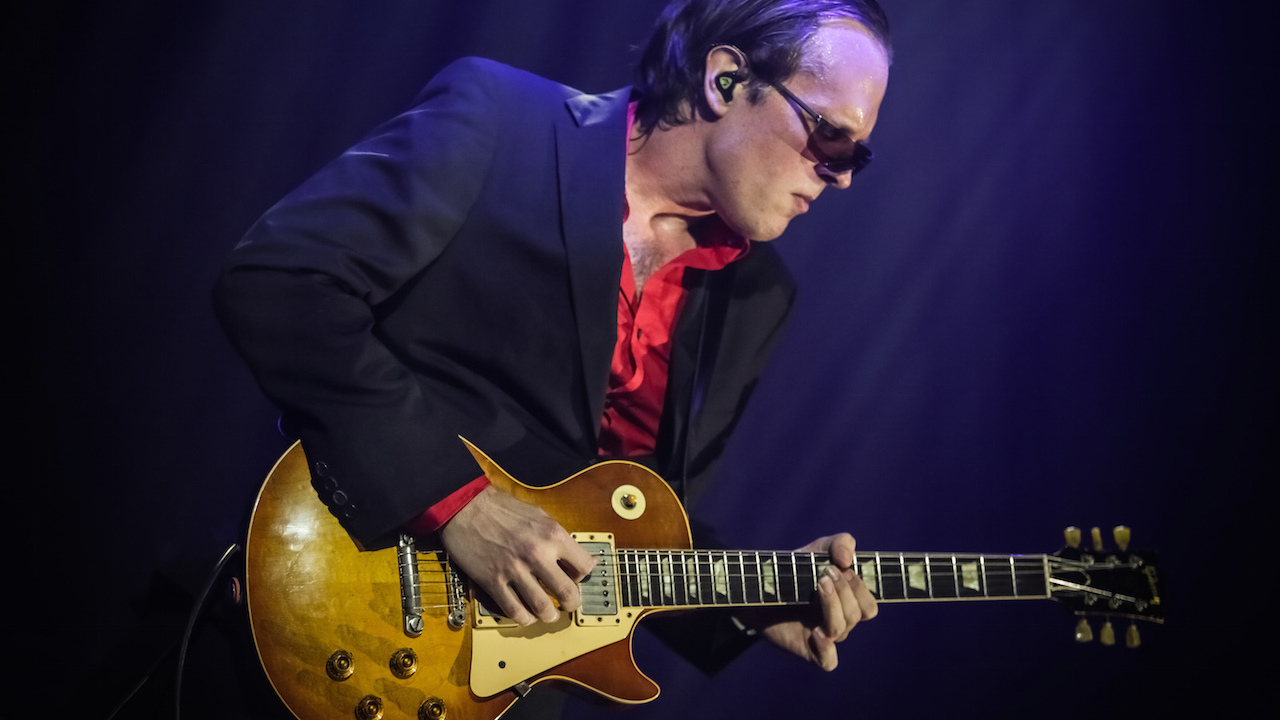
“It’s great to have a signature sound and a style of music that you’re known for, but it’s important to stretch out occasionally and let people know that you can do something different,” says Joe Bonamassa.
The blues titan is discussing his curious involvement with Rock Candy Funk Party, the jazz-funk fusion group led by his touring drummer Tal Bergman that also includes guitarist Ron DeJesus and bassist Mike Merrit. “I have a blast playing with these guys,” Bonamassa says. “The material gives me license to go way out from the kind of music people normally associate me with. I can exercise a part of my playing that’s been left at home for a while.”
Bonamassa refers to himself as something of an “invited guest” in Rock Candy Funk Party, pointing out that the group existed before he started jamming with them at the Baked Potato in Los Angeles several years back. “I’d go on stage with them and do the craziest things,” he recalls, “like a 20-minute version of Fly Like an Eagle. If it was something we could jump on and lend just the tiniest bit of professionalism to, we went for it.”
The band’s 2013 debut, We Want Groove, was born out of a similar moment of spontaneity. Sitting on his tour bus one night with Bergman, Bonamassa floated the idea of recording an album of original material with the group. “I thought it could be loosely based around the sound of Miles Davis’ We Want Miles!” he says. “Musically speaking, you have the head, then there’s a big jam, and you’re out. It’s all based on listening and reacting. That’s how we did the first record, and we had so much fun with it that we decided to do it again.”
Rock Candy Funk Party’s second studio disc, Groove is King, is a richer, more adventurous and decidedly less retro affair than its predecessor. “We were kind of in a ‘70s vibe for the first record,” Bonamassa explains. “This one is a little more produced and modern sounding.”
It also features some of the guitarist’s most unhinged and uncharacteristic playing to date, best exemplified on the electro-funk-soul cut The Fabulous Tale of Two Bands. “It’s sort of Prodigy meets the Brecker Brothers,” Bonamassa notes. “Just wild stuff that keeps you guessing.” The track was recorded in two different sessions, and while on tour in Chicago Bonamassa laid down a solo. At first, the studio’s Randall amp proved a challenge (“it was one of those things with 10,000 knobs – I don’t know how kids use those things”), but after some tweaking and fiddling, Bonamassa found the perfect super-distorted sound that suited the song’s gonzo spirit. “If you hear this solo and don’t know it’s me playing, that’s a compliment,” he states. “I always like to get out of my own head when I play this stuff.”
Music fans familiar with Bonamassa’s recorded work will find a treasure trove of inspiration in a new series of Jam Tracks videos the guitarist has just started rolling out. Beginning with Different Shades of Blue, Love Ain’t a Love Song, Sloe Gin and Oh Beautiful, the guitarist walks aspiring six-stringers through the basics of his best-loved songs. The interactive lessons also feature backing tracks for guitarists to solo over, along with chord diagrams courtesy of Bonamassa’s guitar tech, Mike Hickey.
The latest news, features and interviews direct to your inbox, from the global home of alternative music.
“This all started because of my manager [Roy Weisman],” Bonamassa explains. “He’s been a budding guitarist for 25 years, but in the last three or four years he’s kind of rediscovered the instrument. He jams along to tracks – esoteric, groove-oriented things – and one day he said, ‘What about Joe Bonamassa Jam Tracks? There’s got to be people who’d like to solo for seven minutes over Dust Bowl or Ballad of John Henry – or take your pick.
“I thought it sounded like a good idea, but I wanted to do something different,” he continues. “I said, ‘Let me do some videos.’ I wanted people to see how I did some of the changes. You don’t have to mimic me when you jam along, but if you are wondering how I do certain things, here’s the approach.”
Bonamassa gives props to Hickey for assembling the backing tracks and working on the transcriptions. “It’s a lot of work, and Mike has done a phenomenal job with everything,” he says. “I’ll be honest: I don’t know the damn chords to some of these songs. I recorded them 10, 12 years ago – I don’t remember that shit.”
The guitarist noticed a peculiar aspect to his playing while recording the Jam Tracks videos – he tends to favor minor keys for soloing. “I never really understood that before,” he says. “There’s not a lot of major key stuff going on. I wonder what Freud would have to say about that. It probably speaks to something in my personality.”
Soloing in minor keys does present its potential problems, Bonamassa stresses, citing Love Ain’t a Love Song as a rack loaded with potential potholes. “It’s in B flat minor,” which isn’t the greatest key to solo in,” he says. “It’s good for piano players, but for guitarists it’s kind of tricky. There’s a lot of places you can go with it, but you can get lost pretty easily.” He adds with a laugh. “I know – I’m lost for half my show.”
So how does a guitarist avoid such obstacles? Bonamassa advises players to familiarize themselves with every inch of the fretboard. “Even if you don’t know theory or all the notes, knowing where to go even by just a muscle-memory thing can help,” he says. “When I get into a situation, I can default pretty easily. The trick is to know how to play at every fret in any key. If you can do that, you can get out of trouble. That’s half the battle of playing guitar – staying out of trouble.”
Joe Bonamassa’s Jam Tracks are available on his website, and can be downloaded for offline viewing.
Joe is a freelance journalist who has, over the past few decades, interviewed hundreds of guitarists for Guitar World, Guitar Player, MusicRadar and Classic Rock. He is also a former editor of Guitar World, contributing writer for Guitar Aficionado and VP of A&R for Island Records. He’s an enthusiastic guitarist, but he’s nowhere near the likes of the people he interviews. Surprisingly, his skills are more suited to the drums. If you need a drummer for your Beatles tribute band, look him up.

